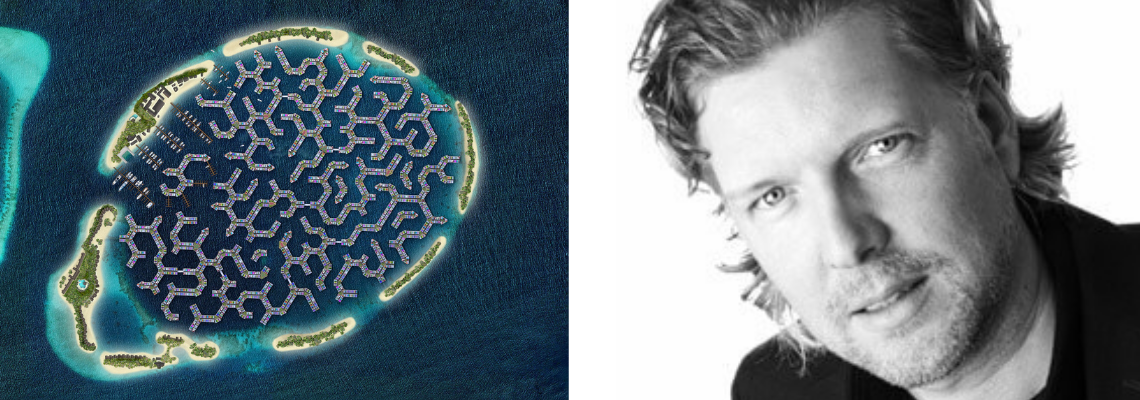Meet the Dutch company that designs floating cities
As climate change and a booming global population continue to put stress on our water resources and living space, could floating cities offer a solution?
Aquatech Online looks at Waterstudio.NL's latest floating development in the Maldives and what drives this unorthodox architectural firm.
If we build it, it will float
By 2050, it is predicted that 70 per cent of the global population live in urbanised areas. Considering that 90 per cent of the world's biggest cities are positioned near water, we need to rethink how cities and water work together.
That's what Dutch architect, Koen Olthuis, has dedicated his life to. His solution? Floating cities.
Born in the Netherlands, Olthuis has always been aware of the challenges water present, with the country sitting about one-third below sea level.
Yet, it was not just water where Olthuis saw issues. Indeed, climate change and a rapidly growing population would also become significant driving forces for his vision.
In 2003 he founded WaterStudio.NR, is an architecture firm specifically for designing floating homes, offices, schools and even hospitals.
But it is Waterstudio.NL's latest endeavour that is causing heads to turn, where construction has begun on a floating city in the Maldives.
Working for the Dutch Docklands Maldives, Waterstudio.NL has turned its floating architectural expertise to help design the floating city of the future.
Overcoming the Maldives’ water challenge
An archipelago of over 1,000 islands, the Maldives is at risk of rising sea levels resulting from climate change. To put this into perspective: 80 per cent of the total land mass of the Maldives is less than one meter above sea level.
Therefore, building cities that can rise with the sea level could be one answer.
Speaking to CNN, Olthuis said: "It can prove that there is affordable housing, large communities, and normal towns on the water that are also safe. They (Maldivians) will go from climate refugees to climate innovators."
Designed in a pattern comparable to that of brain coral, the city will consist of up to 5,000 floating buildings including houses, restaurants, shops and schools, with canals running in between them.
“They will go from climate refugees to climate innovators.”
The current time frame will see residents starting to move in early 2024, with the whole city set to be completed in 2027. In total, the floating city will be able to house 20,000 people. If you want to purchase one of the properties, prices start at $150,000 for a studio or $250,000 for a family home.
How do you build a house on the water?
The floating city will be made of modular units in a nearby shipyard. Once constructed, these units can then be towed to the city where they can be attached to a large underwater concrete hull.
A concrete hull is screwed into the seabed on telescopic steel stilts that allow the units to gently fluctuate with the sea.
Coral beds will surround the city to act as a natural barrier to waves and stop the city from constantly bobbing up and down, preventing residents’ sea sickness.
The city will be self-sufficient and have the same functions as a city on land. Electricity will be generated from a solar generator, meanwhile, sewage will be treated locally and repurposed.
Furthermore, deep water sea cooling will be used as an alternative to air conditioning, pumping cold water from the deep sea into the lagoon, and saving energy.
The Netherlands lead the way
Floating buildings are not new. The Dutch have been pioneering the concept for the past decade and taking on the challenge of trying to change perceptions of them being a 'fad' and instead as a serious solution.
Take the Global Center (GCA) on Adaptation, which in May 2021 moved into its new headquarters: a floating office building anchored in the Rijnhaven, a historical port on the south bank of Rotterdam’s Nieuwe Maas River.
Rotterdam is also home to a floating farm where cows are milked by robots, supplying dairy products to local grocery stores.
The Netherlands is aware of its challenges from rising sea levels and flooding and its embrace of floating buildings is a sign of them taking it seriously.
A recent report from reinsurance agency Swiss Re, revealed that flooding costs the global economy more than $82 billion.
Time will tell to see if these floating cities will catch on. Yet time is one luxury that we do not have in abundance.
Related content
- Rotterdam, resilience and re-design: breakouts highlights/a>
- Floating solar offers revenue boost to water
- Arnoud Molenaar: Rotterdam's resilience leader
Share your water technology stories with us
Do you have an innovation, research results or an other interesting topic you would like to share with the international water technology industry? The Aquatech website and social media channels are a great platform to showcase your stories!
Please contact our Sr Brand Marketing Manager Annelie Koomen.
Are you an Aquatech exhibitor?
Make sure you add your latest press releases to your Company Profile in the Exhibitor Portal for free exposure.
We promise never to send you spam and you can unsubscribe at any time!
